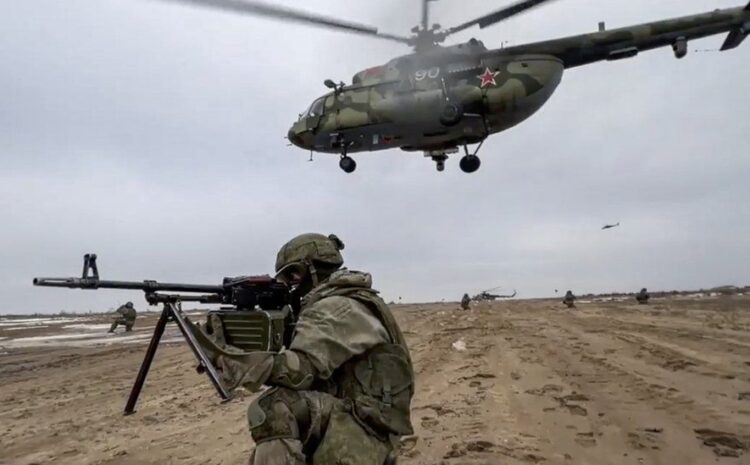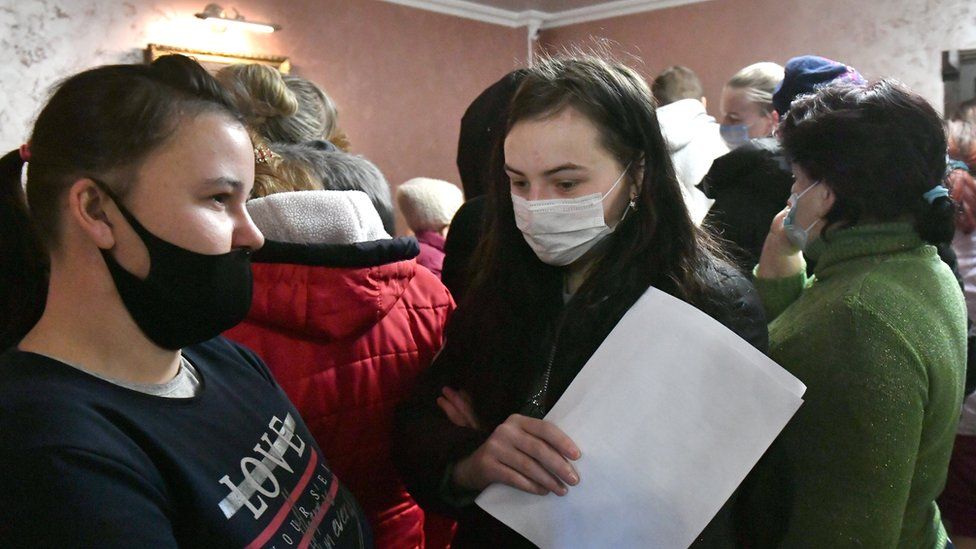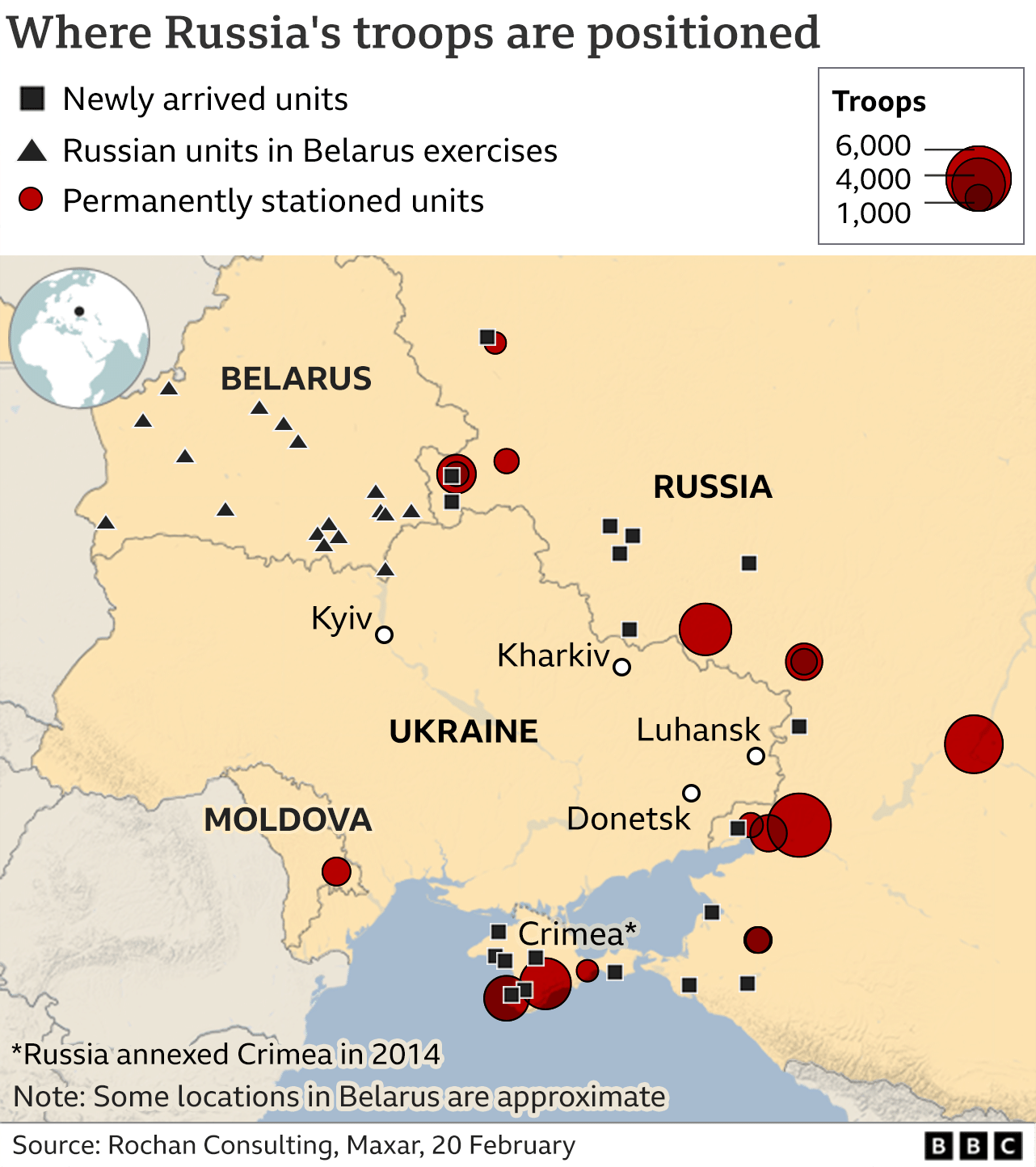
IMAGE SOURCE, EPA Image caption, Russian and Belarusian soldiers have been training together
A statement cited the “deterioration of the situation” in east Ukraine as one reason for keeping an estimated 30,000 Russian troops in Belarus.
The move will add to fears that Russia plans an invasion of Ukraine, which shares a long border with Belarus.
Western leaders have accused Moscow of seeking a pretext to send in troops.
Russia has denied it plans to invade its neighbour.
US Secretary of State Antony Blinken said the extension of military exercises shows the world is on the brink of war.
In a phone call on Sunday, Russian leader Vladimir Putin told French President Emmanuel Macron the Russian troops would eventually leave Belarus, the French presidency said. Mr Putin blamed the Ukrainian military for the escalation of tensions in the Donbas.
There were more explosions in the east Ukrainian conflict zone through the night and into Sunday.
Detonations could be heard from the separatist-held city of Donetsk while both sides said they had come under heavy shell fire.
As explosions boomed out in Donetsk on Sunday morning, Russian-backed rebels in Luhansk accused government forces of crossing the front line to mount an attack which killed two civilians. No proof was given for the allegation but Russian investigators opened an inquiry.
 IMAGE SOURCE, TASS/GETTY
IMAGE SOURCE, TASS/GETTYThe rebels and government forces accused each other of violating the ceasefire dozens of time on Sunday. Two Ukrainian soldiers were killed on Saturday as international monitors reported that ceasefire violations had increased dramatically this week.
Thousands of civilians are being evacuated from the separatist territories into Russia while men of fighting age are being mobilised to fight.
Speaking as she prepared to leave Donetsk for Russia by bus with her four-year-old daughter, an evacuee who gave her name as Tatyana told Reuters news agency: “It’s really scary. I’ve taken everything I could carry.”

The big guns are back
By Orla Guerin, BBC News, Novotroitske
The frontlines in eastern Ukraine are rarely silent – at the very least there is sniper fire between Kremlin-backed rebels and Ukrainian forces. But now the big guns are back. In recent days there has been a barrage of artillery and mortar fire. We heard it ourselves at frontline positions in Novotroitske.
We reached the trenches on foot, crossing flat ground where snow has given way to sucking layers of mud. Two fresh-faced troops led the way, standing stock still at the rumble of shelling a few kilometres away.
Ukrainian forces say they have orders not to return fire – except in exceptional cases – as Russia is “looking for any excuse to invade”.
Taras had a deadpan expression, and a phlegmatic approach to a possible invasion. “They might raze us to the ground,” he told me, “and they might not. And we don’t know if we will have support or not. If it gets too hard, we will open fire too.”

Russia has mustered up to 190,000 troops including separatist forces in the Donetsk and Luhansk regions, according to US estimates.
Western leaders, meanwhile, are preparing sanctions against Russia in case of an invasion.
UK Prime Minister Boris Johnson told BBC News sanctions would hit “very very hard”. He said he had seen evidence Russia is planning “the biggest war in Europe since 1945”.
- EXPLAINER: What is a false flag attack?
- CONTEXT: Satellite images show Russian activity near Ukraine
- BACKGROUND: Is Russia going to invade Ukraine?
The President of the European Council Charles Michel has said the EU is ready to impose massive sanctions on the Kremlin – even harming its own economy if necessary – to confront Russian military aggression.
But Ukraine’s President Volodymr Zelensky has accused Western leaders of a “policy of appeasement” towards Moscow and demanded security guarantees for Ukraine, which officially aspires to join both Nato and the EU.
Mr Putin has been demanding assurances that Nato will not admit Ukraine, a former Soviet state with close ties to Russia, while the Western alliance denies it poses any threat to Russia.
There are fears that a Russian military intervention could start a war even bloodier than the conflict in eastern Ukraine which has cost at least 14,000 lives.

